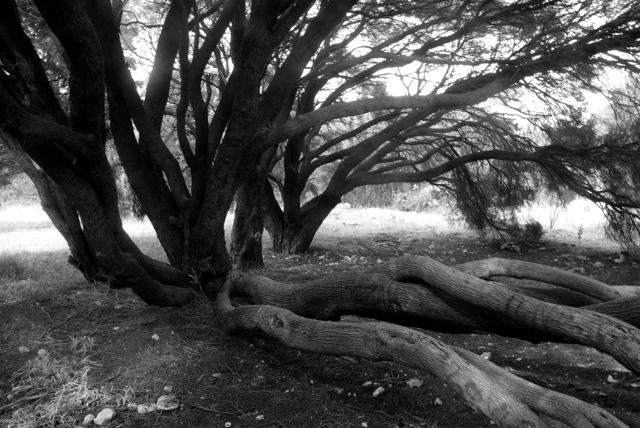 Beach spinifex would have been one of the first thing British folk saw when they piled off their ships in 1829 in south-west Australia. It is still growing in 2008 at Port beach.
Beach spinifex would have been one of the first thing British folk saw when they piled off their ships in 1829 in south-west Australia. It is still growing in 2008 at Port beach.
Then as they stepped past the sand dunes and climbed up some of the hills they would have walked through old groves of Melaleuca lanceolata or Ti Tree. These are harder to find in Fremantle in 2008 than beach spinifex, and I wonder why people don’t plant these beautiful trees in their gardens around town. The trees above are actually growing in a corner of John Curtin High School, my old alma mater.
And then there were the locals to meet. I don’t have any photos of the original people around Fremantle, but this is an image of some original peoples of the East Kimberley from 1910.
Last night I and a group of my friends watched ‘The Tracker’ (2002). Aboriginal societies, of which there were hundreds over the continent were, like humans everywhere, not entirely guiltless of ecological destruction, for example causing the extinction of the marsupial lion. Some societies had habits that appear very strange to modern, Western sensibilities, such as consuming the flesh of other humans in some circumstances. None of them had soft beds to sleep on at night or antibiotics or an advanced culture of respect for the rights of women (women are forcably abducted in many of the Aboriginal myths and stories that I’ve read collected by Ronald M. Berndt). However these first Australians did have much that we Westernized Australians lack. For example: tightly bonded communities, plenty of free time, regular participation in the arts, and a deep bioregional consciousness.
In ‘The Tracker’, along with Rolf de Heer’s other great Aboriginal film ‘Ten Canoes’ (2006), the director represents human life in the Australian landscape as a passing subset of the greater natural world. de Heer does this, for example, with camera shots which start focussing on the human protagonists and then slowly zooming out into a panaroma of wooded mountains until the humans dissapear into the grey-green distance. And de Heer is right to represent the first Australians in this way. For these people the Australian land is not there to be concreted over in globalized homogeneity and then mostly forgotten about, but is invested with stories and symbolic significance, intimately known and interacted with, and recognized as the abiding context of human life.
Last night, in the warm night’s air of Fremantle in early summer, I followed the Aboriginal actor David Gulpilil stepping along the woodland paths in a fictional 1922 and breathing life into the nomadic ways of the first Australians. As I did this I found that I was passing over the littoral of this country, and travelling inland.

